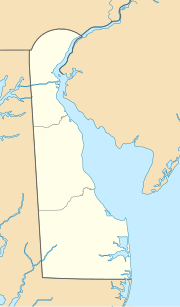Bombay Hook National Wildlife Refuge
| Bombay Hook National Wildlife Refuge | |
| National Wildlife Refuge | |
|
Hundreds of thousands of ducks and geese arrive at Bombay Hook each year to rest
|
|
| Name origin: Corruption of the Dutch "Boompjes" or "Boompjes Hoeck" meaning "little-tree point" | |
| Country | United States |
|---|---|
| State | Delaware |
| Region | Kent County, Delaware |
| Landmark | Delaware Bay |
| Coordinates | 39°15′34″N 75°28′28″W / 39.259473°N 75.474358°WCoordinates: 39°15′34″N 75°28′28″W / 39.259473°N 75.474358°W |
| Area | 25 sq mi (65 km2) |
| Founded | 1937 |
| Owner | U.S. Fish and Wildlife Service |
| For public | Wildlife-oriented recreation |
| Visitation | Open daily |
| IUCN category | IV - Habitat/Species government Area |
| Website: Bombay Hook National Wildlife Refuge | |
The Bombay Hook National Wildlife Refuge is a 15,978 acres (64.66 km2) National Wildlife Refuge located along the eastern coast of Kent County, Delaware, United States, on Delaware Bay. It was established on March 16, 1937 as a refuge and breeding ground for migratory and wintering waterfowl along the Atlantic Flyway. The Refuge was purchased from local land owners with federal duck stamp funds.
Today, the refuge protects wildlife of all kinds, with emphasis on all migratory birds. The refuge also contains the Allee House, a pre-revolutionary war farmhouse on the National Register of Historic Places. It is a stop on Delaware's Coastal Heritage Greenway.
Known to the Native American as Canaresse, meaning "at the thickets," and later referred to as Ruyge-Bosje, meaning "shaggy bushes" or thicket, Bombay Hook received its final name from the corruption of the Dutch "Boompjes" or "Boompjes Hoeck" meaning "little-tree point." In 1679 Mechacksett, chief of Kahansink sold Bombay Hook wetlands to Peter Bayard, an early Dutch settler. The price for the area was one gun, four handfuls of powder, three waistcoats, one anker of liquor, and one kettle.
In 1682, a canal was built from the town of Smyrna to the Delaware Bay; this waterway became the Smyrna River. The Bombay Hook Lighthouse (also called the Smyrna River Lighthouse) was built by the US Government in 1831. The lighthouse was later automated in 1912 and an unmanned light was installed. Arsonists burned the abandoned structure in the early 1970s.
The Allee House, still standing on the refuge, was built in 1753 by Abraham Allee, a Huguenot refugee from Artois, France. It is currently on the National Register of Historic Places. The house remains in nearly original condition.
...
Wikipedia


